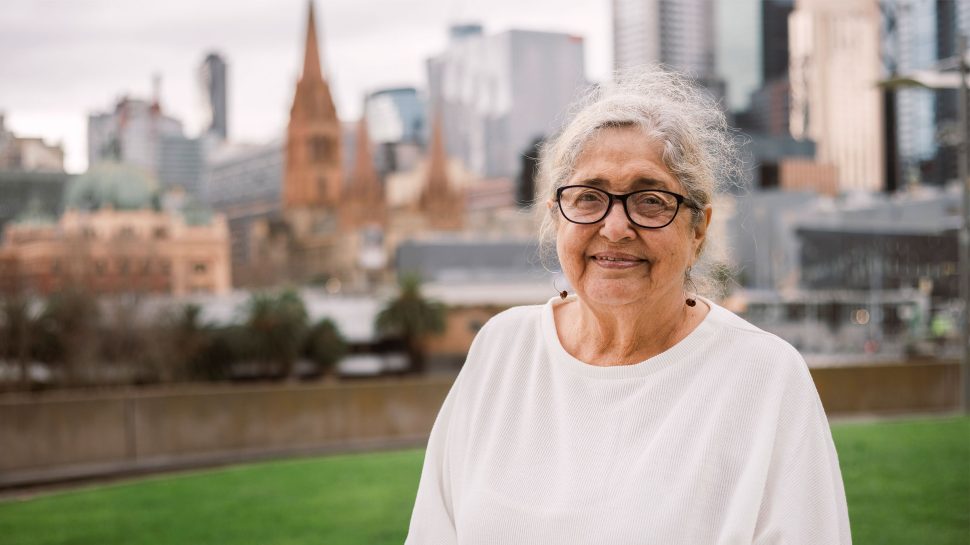Getting to know Gulmmerogin: the Traditional Place name of Darwin
As a comedian and talented singer-songwriter, Senior Larrakia Elder, Uncle Doctor Richard Fejo, knows about jokes. But he thinks using Darwin’s Traditional Place name, Gulmerrogin (gul-merr-gun), when addressing letters and parcels through Australia Post is nothing to laugh at—and everything to celebrate.
The story behind the Traditional Place name, Gulmerrogin
“Gulmerrogin is the Larrakia (la-ruh-kee-yah) word for ‘our land’,” explains Uncle Doctor Richard Fejo. But there is a story behind the word.
“A long time ago there was an old man walking along the beach with his family when he grew tired and decided to have a rest in the shade of the cliffs. His family went around the corner and when he woke up, he called out for them but there was no response. So he created Larrakia people and he told us to go look for his family.”
“At low tide, he walked up to a rock that emerged from the ocean but he didn't realise how fast the tide would come back in. And he got stuck there. Knowing that he would pass away, he lay down and his spirit became that rock. So Larrakia people say today, this is the place where our spirit comes from and our spirit has to return to.”
The Larrakia people have inhabited the Country in and around Darwin for over 65,000 years. They feel strongly about their role as Traditional Owners for the Territory’s capital, looking after visitors to their Country.
Uncle Doctor Richard is a Larrakia man of direct male descent through his father, grandfather and great-grandfather. He has devoted his life to cross-cultural communication and his career has taken him from legal aid to the Darwin Waterfront Corporation to Chair of Larrakia Nation and the Senior Elder on campus at Flinders University.
For him, having Traditional Place names acknowledged on Australia Post letters and packages is significant.
“I think it's really important that we use Traditional Place names because Aboriginal people have a history that's over 60,000 years old that we want to share with everyone,” says Uncle Doctor Richard.
“In Aboriginal culture, kinship and family keep us connected. And now Australia Post, by using Traditional Place names, can keep all of us even more connected.”

Introducing Traditional Place names at Australia Post
In November 2020, Australia Post made a significant stride during NAIDOC Week by revising the addressing guidelines to incorporate Traditional Place names. This progressive move aimed to recognise and honour the enduring connection between Indigenous peoples and the land they inhabit.
After Gomeroi (guum-a-roy) woman Rachael McPhail advocated for the inclusion of Traditional Place names in mailing addresses on various social media platforms, an overwhelming response of interest and support from the general public followed suit.
To build on this important initiative, Australia Post has created an empowering video on what Traditional Place names mean to Indigenous peoples—in their own words.
The video features Indigenous Elders, like Uncle Doctor Richard, as well as Indigenous community leaders and business owners, sharing and celebrating Indigenous language and inspiring everyone to use Traditional Place names.
For Uncle Doctor Richard, being able to use Traditional Place names when addressing letters or parcels through Australia Post brings him personal joy.
“I can just imagine the surprise on my niece's face when I send her a package from Australia Post that says Gulmerrogin on it,” says Uncle Doctor Richard. “She's going to love it.”
Embracing the movement
For Shaun Edwards, proud Larrakia man, former professional AFL player and founder of Gulmerrogin-based fashion and lifestyle social enterprise, House of Darwin, using Traditional Place names on Australia Post parcels and letters makes perfect sense.
“All our t-shirts use different graphics and iconography that we pull from different stories around the communities and then portray over different garments,” explains Shaun. “We put Traditional Place names on our t-shirts and encourage people to learn about the Country they are on.”
“We use the t-shirts as an educational tool for different people around Australia to engage with First Nations people. Using Traditional Place names on our packaging is an extension of that.”
For Shaun, sharing knowledge promotes understanding. “We proudly say we want to inspire people to seek knowledge and using Traditional Place names is part of that.”
Embrace your place: start using Traditional Place names on your parcels today
To find an area’s Traditional Place name, check the map on the AIATSIS website or get in touch with Aboriginal and Torres Strait Islander Land Councils or Cultural Centres in your area.
Using Traditional Place names
Using Traditional Place names
Here’s a handy guide to addressing mail and parcels with Traditional Place names.



